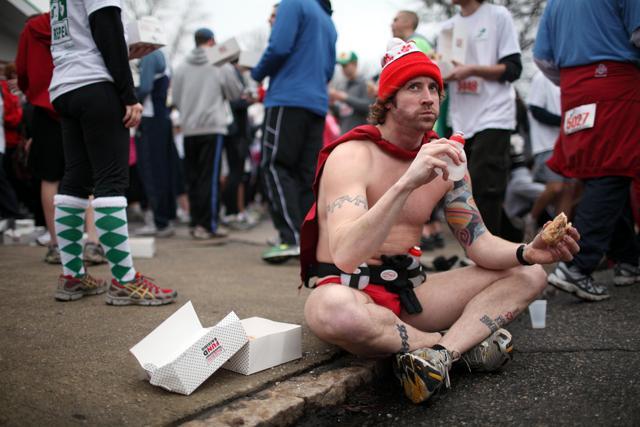
©
Clint Bollinger of Charlotte sits on the ground as he works on eating his dozen doughnuts during the 2010 Krispy Kreme Challenge. Photo by Matt Moore
The Krispy Kreme Challenge has made its way into becoming an essential tradition at N.C. State, but few people consider the most critical part of the race itself—the preparation. However, there are key strategies to keep in mind while training and competing in the race, which raises funds for the North Carolina Children’s Hospital.
Months of preparation go into the popular race. This prep ranges from the people working at Krispy Kreme, to the runners preparing for the big event themselves.
Krispy Kreme’s throughout North Carolina are hard at work the night before the race in preparation for the following morning. Due to the prior preparation, however, the real challenge to competitors is how to keep the stale, premade doughnuts in their stomachs the entire time.
Like most competitions, each person is different, and therefore require different approaches to preparation.
“Just run as much as you can and get in shape for the race,” says Taylor Garrison, a sophomore in mechanical engineering. Garrison ran the race last year and will run again this February. Preparing for the race, Garrison and his roommates have run the four-mile course to practice the race experience. In addition to running, Garrison is equally concerned about the eating portion.
“Basically, we are trying to train for the other aspect of the race, which is stuffing our face as much as possible,” said Garrison.
John Stevens, a senior in biological sciences and last year’s seventh place finisher with a time of 33:07 minutes, had a few different training methods.
“As far as eating, I did no training at all,” Stevens said. “It seems like training by eating a lot of doughnuts would be counterproductive for the running part.” In regards to running, Stevens suggested that the more long-distance runs incorporated into one’s training plan, the better for race preparation.
“The long runs are really critical because people are used to doing 5ks (3.1 miles) and this is longer than that,” Stevens said. “A really important thing is also to rest a day or two before the race. Running a day or two before will hurt more than it helps.”
Some people train prior to the event, but others jump right into the challenge, ready to bear the pain of not conditioning. Sudeep Sunthankar, co-Chair of the KKC and a senior in biomedical engineering, felt she underestimated the rigor of the challenge.
“I ran the race as a freshman and was a bit naïve,” Sunthankar said. “I tried to simply eat the doughnuts with no real strategy, so I would definitely recommend finding some sort of technique if the participants are serious about completing the challenge in under one hour.”
Stevens employed a technique of eating three sets of doughnuts in the past, in which he took four doughnuts and smashed them together. Water is also provided for the runners while they are trying to down the food.
“The more water the better because your mouth is dry after running two miles fast,” Stevens said. “A good mixture of dunking the doughnuts in the water is really beneficial.”
“Since Krispy Kreme donuts are mostly air, this removes a lot of unnecessary effort,” said Rachel Turner, a junior in animal science and another co-Chair of the event. “However, I’ve also seen people rolling their doughnuts into balls, which seems to work well.”
At last year’s event, Garrison viewed a few interesting techniques people implemented in the doughnut-binge part of the competition.
“We saw people doing ‘the Kobayashi’ like the hot dog eating contest and dunking it in water,” said Garrison, referring to the Japanese eating-competition champion. “I tried doing it, but it was disgusting on so many levels.”
Running back on the uphill portion of the race, however, is a trial of its own.
“If you approach it seriously,” Stevens said, “you should expect the last two miles to be really tough and kind of grueling.”
According to John Yanik, a junior in biomedical engineering and another co-chair of the KKC, the hardest part of the race is the last six doughnuts and the return leg of the run.
“I would suggest that serious competitors go all out on the run down because odds are you’re going to be slower on the way back,” Yanik said.
On the returning route, the course increases in difficulty.
“Peace Street has some large hills on it,” Yanik said. “On the way back, this is typically where most people lose it.”
Upon reaching the finish line, most runners have mixed feelings. “Finishing is my favorite and least favorite part,” Garrison said. “Both the relief of actually finishing it and having to deal with the agonizing pain from putting yourself into that kind of situation makes it a bittersweet moment.”
This year’s race will begin on Feb. 5th at 8:30 a.m.
“If someone is serious about the race and trying to do well, make sure to get there early because the race is so big now, you can’t even get to the front,” Stevens said.
Even though Stevens started near the front, he was still boxed in at the beginning of last year’s race.
For many students at N.C. State, the KKC has been a memorable experience and a tradition for the past seven years since the idea was first conceived in 2004.
“I’m happy to be a part of it,” Garrison said. “I really look forward to it every year that I’m here.”